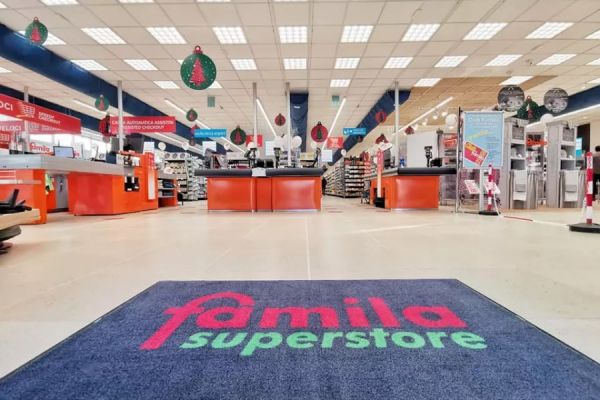For months, a digital clock has counted relentlessly down - minutes, hours, days - inside the headquarters of Wal-Mart Stores Inc.
The timer was set up after Greg Foran, head of the company’s U.S. operations, made Oct. 1 a “line in the sand” for transforming Wal-Mart into a cleaner, easier and friendlier place to shop. The 54-year-old executive has crisscrossed the country visiting stores, trying to bring them up to par.
The clock hit zero on Thursday - and Foran is still at work.
While many Wal-Mart locations are now in better shape, some are lagging behind. And Foran is continuing his torrid pace of surprise visits, aiming to spot problems in the sprawling chain of 4,600 U.S. stores. Wal-Mart has made progress on its key priorities - making checkout lines shorter, for instance - but the company is still pushing to bring costs lower and improve efficiency. In that vein, Wal-Mart said on Friday that it was cutting 450 workers at its headquarters.
“While difficult, I believe these changes will help us become a more nimble organisation that serves customers better,” chief executive officer Doug McMillon said in a memo to employees. “Our customers are changing, retail is changing, and we must change. We need to become a more agile company that can easily adapt to shifting customer demand.”
At stake is Wal-Mart’s legacy as the king of discount chains, a reputation built on Sam Walton’s nonstop pursuit of lower prices. The Bentonville, Arkansas-based company had drifted away from Walton’s ideals in recent years, allowing costs to increase while its standards slipped, executives have said. Wal-Mart also faces fiercer Amazon.com Inc. competition, a stock slump and a broader slowdown in big-box retail.
Store Checks
Foran’s crusade to improve Wal-Mart’s tarnished reputation has sent him on visits to more than 150 stores in 30 states over the past year. He’s studied everything from how easy it is to get a shopping cart to how individual items are placed on the shelves - things customers often aren’t paying attention to but can contribute to their overall impressions.
The tours have also had the effect of putting store managers on notice that top executives may drop in at any moment. Last year, Foran gave his personal e-mail to every store manager, letting them share suggestions and concerns. The New Zealander, who previously worked at Australia’s Woolworths Ltd., has responded to hundreds of them so far.
“Maybe they are not ubiquitously achieving their goals across the U.S., but it is certainly a significant improvement,” said Burt Flickinger, managing director at Strategic Resource Group, a consulting firm that visits about 50 to 100 Wal-Mart stores a month. “They have come a retail light year in terms of where they were two years ago.”
Holiday Season
The Oct. 1 milestone was a way for Foran to bring urgency to Wal-Mart’s stores as they head into the holiday season - the first one since McMillon put his turnaround plan into place earlier this year. The holidays can make or break a retailer’s year, and Wal-Mart is in much need of a boost. Earnings fell short of analysts’ estimates last quarter, and the company trimmed its forecast for the year. Wal-Mart’s stock has lost more than a quarter of its value in 2015.
Wal-Mart executives have admitted that the retail giant lost its way. Once seemingly unstoppable, the company has watched customers defect to Amazon, dollar-store chains, and regional grocery stores such as Kroger Co. and Publix Super Markets Inc.
Unclean Stores
Wal-Mart shoppers have complained that the stores were dirty, the shelves were empty, and the prices weren’t as competitive as they once were. The goal over the past year was straightforward: Stores should be tidy, staff should be friendly, and customers should be able to get in and get out quickly. But getting there hasn’t been simple.
Part of the plan is to use wage increases to make workers happier and more productive, which Wal-Mart hopes will lead to better customer service. The company is spending $1 billion this year to boost pay and offer better training. It’s also reorganized the management structure in its stores and added additional hours to make sure more checkouts are open during peak times. The retailer has even adjusted the temperature and changed the employee dress code to help improve the working conditions for its 1.3 million employees.
The increased spending has added pressure to reduce costs elsewhere. In addition to the job cuts at headquarters, the company is seeking more concessions from suppliers - part of a renewed focus on its everyday-low-price strategy. Wal-Mart has gotten more aggressive about asking vendors to pay fees for using its warehouses and distribution centres to shuttle products to store shelves.
Shopper Feedback
Wal-Mart relies on customer feedback and a complex algorithm to rate its stores. The company surveys more than 3 million shoppers each quarter, asking them to rank their experience from one to 10 in several categories. The results are plugged into a computer model that analyses the progress each store is making, and managers get daily updates on the results. The stores can drill down into the data to see the areas they need to improve on most and how customers rank their experience based on the time of day or day of the week.
The effort has led to shorter checkout lines, cleaner restrooms, and improvements in the quality of meat and dairy products, Flickinger said. The stores are still struggling with out-of-stock items and poor-quality produce, though, he said.
Sales Gain
The changes have been slow to show up in Wal-Mart’s financials, but there have been signs of improvement. Despite profit falling short of predictions last quarter, same-store sales increased 1.5 per cent. That marked a rebound from earlier declines and exceeded analysts’ estimates.
Wal-Mart still has a ways to go, especially with its grocery business, which makes up more than half of its nearly $500 billion in annual revenue, said Wayne Hood, an analyst at BMO Capital Markets.
Wal-Mart trails its supermarket peers in customer satisfaction because of poor service, the inconvenience of its large stores and the condition of produce, Hood said in a research report last month. To grow, Wal-Mart can’t just match its competitors - it will need to do even better, he said.
“This may require a transformational change in the company’s culture,” he said. Rather than just focusing on having the lowest cost, Wal-Mart may need to get workers who are both knowledgeable and engaged, Hood said. “It’s rare to find a store associate asking someone if they need help.”
News by Bloomberg, edited by ESM. To subscribe to ESM: The European Supermarket Magazine, click here.














